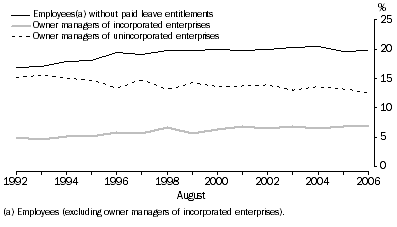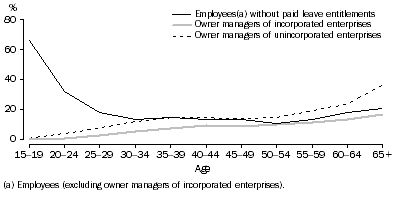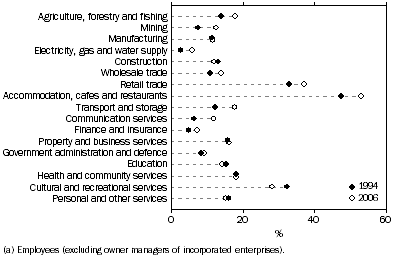This article was published in the July 2007 issue of Australian Labour Market Statistics (cat. no. 6105.0).
SPOTLIGHT ON EMPLOYMENT TYPE
INTRODUCTION
The nature of employment in Australia has been changing over the past two decades. People have been particularly interested in the rise in part-time and 'casual' employment during this time. Related issues of interest are changes in the types of benefits for employees, such as leave entitlements, and the extent of self-employment.
The ABS has developed an annual time series on the types of employment that people have, including information on employees who are not entitled to paid sick or holiday leave (used as a proxy for 'casual' employees), and people who operate their own business. The series are derived by combining data from the Labour Force Survey (LFS) and the Survey of Employee Earnings, Benefits and Trade Union Membership, conducted as a supplement to the August LFS each year. The time series has now been updated to cover August 1992 to August 2006.
The October 2004 issue of Australian Labour Market Statistics (cat. no. 6105.0) contains an article 'Changes in types of employment' that presents time series data and discusses the classification and methodology used to construct the time series. More detail can be found in an appendix to the October 2004 article, available from the ABS web site. This spotlight presents an update of the time series to August 2006.
To allow comparison over time, the occupation and industry classifications referred to in this article, and those contained in the Employment Type spreadsheet, are from the Australian Standard Classification of Occupations (ASCO), 1997 (Second Edition), and the Australian and New Zealand Standard Industrial Classification (ANZSIC), 1993.
EMPLOYMENT TYPE
The series presented in this article are for the following types of employment:
- employees (excluding owner managers of incorporated enterprises)
- employees with paid leave entitlements
- employees without paid leave entitlements
- owner managers (end note 1)
- owner managers of incorporated enterprises (OMIEs) (end note 2)
- owner managers of unincorporated enterprises (OMUEs) (end note 3)
CHANGES IN TYPES OF EMPLOYMENT
The most common type of employment in main job continues to be employees (excluding owner managers of incorporated enterprises) entitled to paid sick or holiday leave, with a 61% share of employment in August 2006. This figure has remained relatively stable in recent years. While the proportion of employees (end note 4) with paid leave entitlements declined from 1992 to 1997 (62% to 60%), there has been little change since this period.
As shown in graph 1, employees (end note 4) without paid leave entitlements rose as a proportion of total employment, from 17% in 1992 to 20% in 1998. Since 1998 the proportion has remained relatively stable.
In August 2006, owner managers made up 19% of all employed people. This is similar to the situation in 1992, and it has remained relatively stable since then. However, the split between owner managers of incorporated and unincorporated enterprises has changed over time.
Graph 1 shows that the proportion of owner managers of incorporated enterprises gradually increased to 7% in 2006 (compared to 5% in 1992). In contrast, the proportion of owner managers of unincorporated enterprises declined over the period, from 15% in 1992 to 13% in 2006.
1. TYPES OF EMPLOYMENT, Proportion of employed - 1992-2006

Women make up more than half of all employees (end note 4) without paid leave entitlements. This reflects the fact that women are more likely to be in part-time work than men and that part-time workers (end note 5) are more likely to be employees (end note 4) without paid leave entitlements. In 1992, women made up almost two-thirds (64%) of employees (end note 4) without paid leave entitlements. By 1998 this had declined to 58%, and since then it has remained relatively stable.
Men are far more likely to be owner managers than women. In August 2006, more than two-thirds (70%) of owner managers of incorporated enterprises were male (down from 73% in 1992), as were two-thirds (67%) of owner managers of unincorporated enterprises (down from 68% in 1992).
AGE
Younger people, particularly those aged 15 to 24 years, are much more likely to be working as an employee (end note 4) without paid leave entitlements than people in other age groups. In August 2006, almost two-thirds (66%) of employed people aged 15 to 19 years were employees (end note 4) without paid leave entitlements (compared to 54% in 1992), as were almost one-third (32%) of employed people aged 20 to 24 years (compared to 23% in 1992). One reason for this is the higher participation of young people in part-time work compared to other age groups. This in turn reflects their participation both in education and in the labour force.
2. EMPLOYMENT TYPE, Proportion of employed by age - August 2006

The likelihood of being an owner manager generally increases with age. Of employed people aged 65 years and over, 36% (76,800 people) were owner managers of unincorporated enterprises (compared to 56% or 58,100 people in 1992), and 17% (35,600 people) were owner managers of incorporated enterprises (compared to 11% or 10,900 people in 1992).
FULL-TIME / PART-TIME
The most common type of employment continues to be an employee (end note 4) with paid leave entitlements working full-time. The proportion of this employment type declined from 56% in 1992 to 52% in 1998. Since then, it has remained relatively stable, declining slightly to 51% in 2006.
3. Employed persons, Type of employment in main job - by Full-time/part-time status in all jobs - 1992 and 2006 |
|
 |  | Proportion of employed
|  |  |
 |  | Full-time | Part-time | Total | Total | Proportion employed
part-time |
 |  | % | % | % | '000 | % |
|
| 1992 |  |  |  |  |  |
 | Employees* with paid leave entitlements | 55.6 | 6.5 | 62.0 | 4 738.3 | 10.4 |
 | Employees* without paid leave entitlements | 4.2 | 12.8 | 16.9 | 1 294.3 | 75.3 |
 | Owner managers of incorporated enterprises | 4.0 | 0.8 | 4.9 | 372.2 | 17.4 |
 | Owner managers of unincorporated enterprises | 11.2 | 3.9 | 15.2 | 1 157.0 | 25.8 |
 | Total(a) | 75.3 | 24.7 | 100.0 | 7 636.7 | 24.7 |
| 2006 |  |  |  |  |  |
 | Employees* with paid leave entitlements | 50.6 | 10.1 | 60.7 | 6 176.0 | 16.6 |
 | Employees* without paid leave entitlements | 6.3 | 13.4 | 19.7 | 2 001.8 | 67.9 |
 | Owner managers of incorporated enterprises | 5.4 | 1.4 | 6.8 | 690.4 | 21.2 |
 | Owner managers of unincorporated enterprises | 8.7 | 3.9 | 12.5 | 1 275.2 | 30.8 |
 | Total(a) | 71.0 | 29.0 | 100.0 | 10 172.0 | 29.0 |
|
| (a) Total includes 'Contributing family workers'. |
| * Employees (excluding owner managers of incorporated enterprises). |
Employees (end note 4) without paid leave entitlements are heavily concentrated among part-time workers. In August 2006, 68% of employees (end note 4) without paid leave entitlements worked part-time (down from 75% in 1992). The largest group of employees (end note 4) without paid leave entitlements were women who worked part-time, making up almost half (45%) of this employment type.
In 2006, full-time men accounted for just over one-fifth (21%) of employees (end note 4) without paid leave entitlements, compared to just 11% of full-time women.
OCCUPATION
Data on occupation and employment type are available from 1996 onwards. Employees (end note 4) without paid leave entitlements tend to be concentrated in the two lowest skills occupations - skill level 4 (comprising Intermediate clerical, sales and service workers, and Intermediate production and transport workers) (end note 6) and skill level 5 (comprising Elementary clerical, sales and service workers, and Labourers and related workers). (end note 6)
Between 1996 and 2006, much of the growth in the number of employees (end note 4) without paid leave entitlements occurred in skill levels 4 and 5; these two skill levels accounted for 75% of all employees (end note 4) without paid leave entitlements in 2006.
The largest percentage increase in employees (end note 4) without paid leave entitlements occurred in skill level 2. Between 1996 and 2006, there was a 57% increase in the number of employees (end note 4) without paid leave entitlements in this skill level, which comprises Associate professionals.
4. Number of persons who are employees* without paid leave entitlements, by Occupation |
|
 | 1996
| 2006
| Difference
|
| Occupation(a) | '000 | % | '000 | % | '000 | % change |
|
| Skill level 1 | 167.7 | 10.3 | 212.9 | 10.6 | 45.1 | 26.9 |
| Skill level 2 | 67.1 | 4.1 | 105.1 | 5.2 | 38.0 | 56.7 |
| Skill level 3 | 192.4 | 11.8 | 182.1 | 9.1 | -10.3 | -5.4 |
| Skill level 4 | 476.8 | 29.3 | 637.9 | 31.9 | 161.1 | 33.8 |
| Skill level 5 | 722.6 | 44.4 | 863.9 | 43.2 | 141.3 | 19.6 |
| Total | 1 626.6 | 100.0 | 2 001.8 | 100.0 | 375.2 | 23.1 |
|
| (a) For more detail on skill level see the Australian Standard Classification of Occupations, Second Edition (cat. no. 1220.0). |
| * Employees (excluding owner managers of incorporated enterprises) |
INDUSTRY
Spreadsheets showing a breakdown by industry are available from 1994 onwards. In August 2006, the proportion of employees (end note 4) without paid leave entitlements was highest in three main industries: Accommodation, cafes and restaurants (53%), Retail trade (37%), and Cultural and recreational services (28%). This reflects the fact that these industries have high proportions of part-time workers. (end note 5)
There was little increase in the proportion of employees (end note 4) without paid leave entitlements across most industries from 1994 to 2006. However, the proportion of employees(end note 4) without paid leave entitlements in the Mining industry rose from 8% to 13% between 1994 and 2006, and from 6% to 12% in the Communication services industry. These two industries also have the highest percentage increase in employees (end note 4) without paid leave entitlements between 1994 and 2006.
5. Employees(a) without paid leave entitlements, by Industry

In August 2006, the industry with the largest proportion of owner managers of incorporated enterprises was Construction (13%). The industry which had the greatest proportion of owner managers of unincorporated enterprises was Agriculture, forestry and fishing (48%).
FOR FURTHER INFORMATION
An updated spreadsheet containing the annual time series on employment type from 1992 to 2006, is now available from the ABS web site. To find the spreadsheet go to <https://www.abs.gov.au> [Statistics - By Catalogue Number - 6. Labour Statistics and Prices - 61. Labour statistics - general]. The spreadsheet is listed under the Details tab in this July 2007 issue of Australian Labour Market Statistics (cat. no. 6105.0). The employment type spreadsheet includes estimates of employment type by sex and full-time/part-time status for each of the following variables: age (five year age groups), state of usual residence, industry and occupation.
Employment type data can also be obtained from the Forms of Employment Survey. An article highlighting data from the November 2006 survey is included in this issue of Australian Labour Market Statistics (cat. no. 6105.0). This provides a more detailed employment type classification including employees (end note 4) working on a fixed-term contract and owner managers working on a contract basis.
For further information about the concepts and methods used in compiling this Employment Type time series, see the 'Changes in types of employment' article in the October 2004 issue of Australian Labour Market Statistics (cat. no. 6105.0). For further information, please call (02) 6252 7206.
END NOTES
1. Owner managers are people who work in their own business, with or without employees, whether or not the business is of limited liability.Back
2. Owner managers of incorporated enterprises are people who work in their own incorporated enterprise, that is, a business entity that is registered as a separate legal entity to its members or owners (also known as a limited liability company). They are technically employees although they are more similar in characteristics to owner managers of unincorporated enterprises (i.e. self-employed people).Back
3. Owner managers of unincorporated enterprises are people who operate their own unincorporated enterprise, that is, a business entity in which the owner and the business are legally inseparable, so that the owner is liable for any business debts that are incurred. Includes those engaged independently in a trade or profession.Back
4. Employees (excluding owner managers of incorporated enterprises).Back
5. Part-time workers are employed people who usually worked less than 35 hours a week (in all jobs) and either did so during the reference week, or were not at work in the reference week.Back
6. For more detail on skill level see the Australian Standard Classification of Occupations, Second Edition, 1997 (cat. no. 1220.0).Back
 Print Page
Print Page
 Print All
Print All